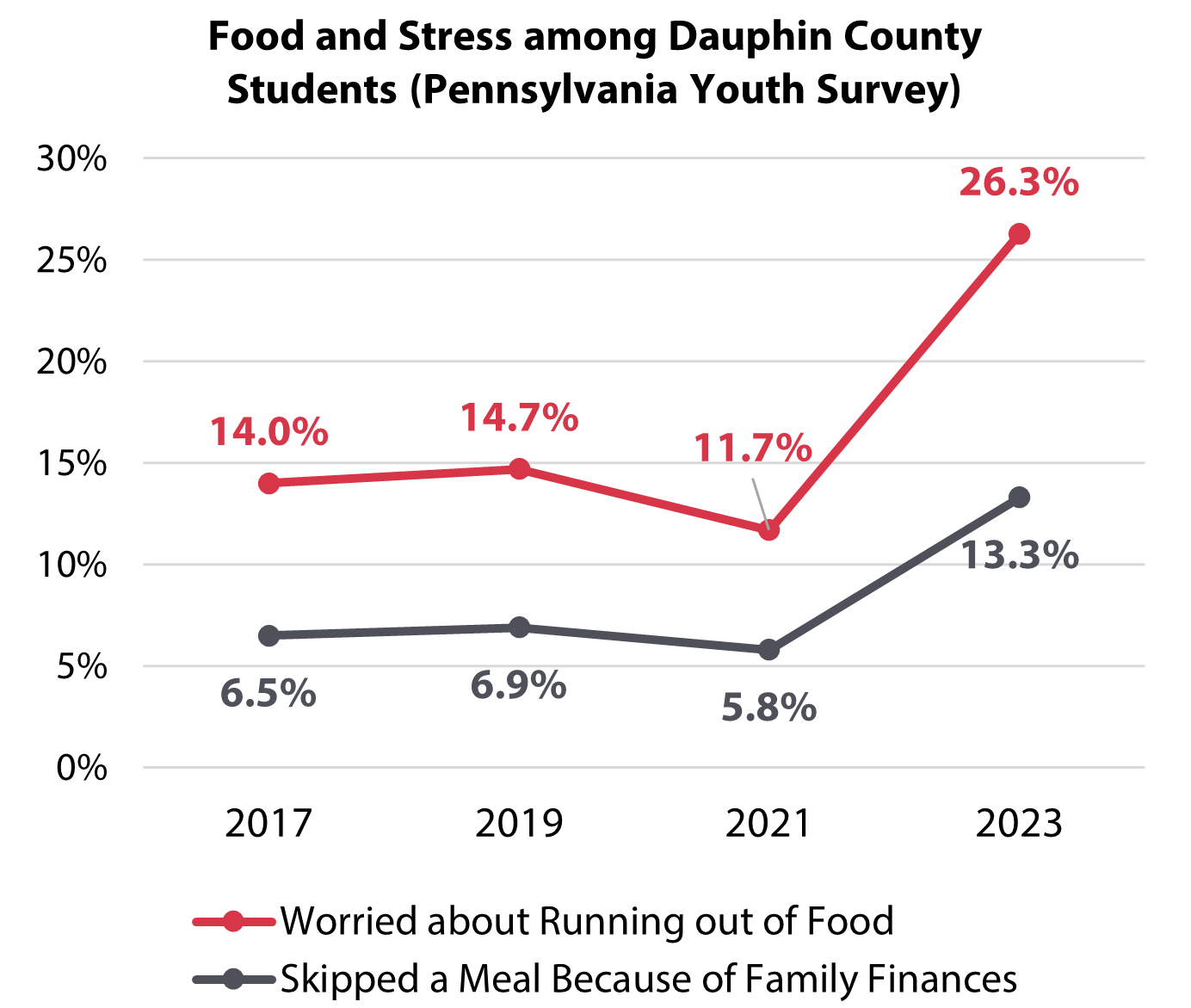by Morgan Flood, Policy Research Specialist
The Central Pennsylvania Food Bank’s Dauphin County Community Hunger Mapping report will be released next month. To create the report, the CPFB Impact and Policy Research team gathered and analyzed both publicly available and privately gathered data over eighteen months to better understand the dispersion, experiences, and causes of food insecurity across Dauphin County. A key result discussed in the final report is that child food insecurity is a particularly severe issue in the county. This policy blog previews this critical finding and highlights opportunities for the local charitable food system and other stakeholders to strengthen their efforts to alleviate child hunger.

About one in nine (11.3%) residents of Dauphin County experienced food insecurity as of Feeding America’s most recent Map the Meal Gap estimates. However, food insecurity is not evenly spread across the county’s residents; food insecurity has disparate impacts on members of different demographic groups, including children. Of the 32,200 food insecure individuals in the county, 12,400 were under the age of eighteen.
Though there were fewer food insecure children than adults in the county in 2022, its burden weighed inequitably on young people. Children made up almost two fifths (38.5%) of the total food insecure population, and one in five (19.5%) children were unsure where their next meal would come from, making them 120% more likely than adults to be food insecure. This proportion is the second highest ratio of child to adult food insecurity by county in the entire Commonwealth of Pennsylvania, after only Philadelphia.
Given these startling statistics, it is clear that child food insecurity is a very serious issue in Dauphin County; unfortunately, the problem is worsening over time. Between 2021 and 2022, child food insecurity jumped 34%, rising from 14.6% in 2021 to 19.5% in 2022, according to Feeding America. These local spikes in food insecurity were in line with statewide and national trends in food insecurity and poverty in this time frame.
Data from the Pennsylvania Youth Survey (PAYS), a biannual survey conducted by the Pennsylvania Commission on Crime and Delinquency, also reflect the alarming rise in child food insecurity over the last few years, as seen through the eyes of the children experiencing it.
PAYS asked Pennsylvania students in 6th, 8th, 10th, and 12th grades if they worried about running out of food or had skipped a meal because of their family’s finances in the past year. In Dauphin County in 2023, more than a quarter of surveyed students (26.3%) reported that they worried about running out of food and about one in eight (13.3%) actually skipped a meal because of their family’s financial situation. In both cases, rates were more than twice those seen in 2021, the prior survey year, and were higher than the Feeding America food insecurity estimates.


Data from the charitable food network further illuminates the severity of child food insecurity in Dauphin County. The results of surveys conducted at pantries across the county in 2024, as part of the Community Hunger Mapping process, show that just over half (51%) of all pantry visitor households are households with children.
Households with children are also more likely than other pantry visitor household types to have reported that they face very low food security, the most severe form of food insecurity. Households experiencing very low food security skipped meals in the last year due to lack of money for food. Sadly, 43% of survey respondent households with children reported experiencing very low food security, which is significantly higher than among senior-only households and almost as high as working-age households without children.
These results also align with and can be expanded upon via an analysis of American Communities Survey (ACS) poverty by family type estimates; since poverty is the primary driver of food insecurity, assessment of this data can provide more granular insight into the uneven distribution of food insecurity across different household types. For the purposes of this analysis, a family is defined as two or more related people living together. Unmarried couples, roommates, and people living alone or in other housing arrangements are not counted as families.
s of 2023, families with children made up just under half (43.7%) of the family households in Dauphin County but were more than three quarters (75.5%) of families in poverty because of their elevated poverty rates. The overall poverty rate for families with children was 72% higher than the overall family poverty rate at 15.9% versus 9.2%. A closer look shows that single-adult families with children had an astonishing 34.3% poverty rate; these families accounted for almost two thirds (65.6%) of all families in poverty.

In light of the depth, scope, and scale of child poverty and food insecurity in Dauphin County, it is critically important for the charitable food system to focus on being as accessible as possible to households with children and to place additional emphasis on accommodating single-adult households who may face additional barriers to access such as a lack of childcare. Steps pantries can take to improve accessibility for households with children include offering robust evening and weekend hours for working families, being welcoming to children visiting pantries with their parents or guardians, and minimizing onerous paperwork and documentation requirements. Stakeholders outside the charitable food system can also take action for children facing hunger by advocating for key government programs such as WIC, school breakfast and lunch programs, and summer nutrition programs across the county.
The forthcoming Dauphin County Community Hunger Mapping report features much more analysis on both this and a variety of other topics, as well as a number of specific, actionable recommendations that can help the charitable food network better serve those most likely to experience food insecurity. To learn more, stay tuned for the full report!
